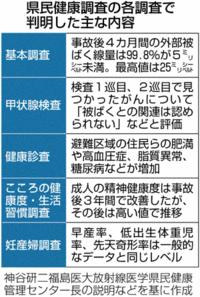Fukushima Mino [Verification / Decommissioning] Contacted water countermeasures, "Control" that does not involve the actual situation in the middle
"The situation is controlled. We never damage Tokyo."A general meeting of the International Olympic Committee (IOC) held in Buenos Aires on September 7, 2013.In the final presentation over the 2020 Summer Olympics, Shinzo Abe, the Prime Minister, said about the response to contaminated water at the Fukushima Daiichi Nuclear Power Plant.
After the nuclear accident in March 2011, the urgent challenge was to cool down the melted nuclear fuel (debris).A large amount of water, including seawater, was injected into the reactor.In addition, groundwater and rainwater flowed into the building, and it was contaminated with radioactive materials such as debris.The government declared the reactor "cold -temperature stop" in December, and seemed to have escaped the worst time.
However, responding to contaminated water increasing every day did not progress.It was decided to start from the building and store it in an underground water tank or ground tank, but troubles occur frequently in 2013.In April, a leak from the underground aquarium was discovered.In July, TEPCO acknowledged that contaminated water was leaking from the building to the ocean.In August, an accident occurred in which a high concentration of 300 tons of contaminated water was leaked from the tank.
The tank was a form of tightening the steel plate with a bolt, which was built in a hurry.TEPCO's management system was also revealed, and the contaminated water problem became an interest inside and outside.The Olympics were invited to the Olympics, and the contaminated water problem was nothing but a negative factor.On September 3, the government will hold a meeting of the Nuclear Disaster Countermeasures Headquarters to formulate a basic policy for contaminated water.
Abe spoke at the IOC General Assembly just four days later.It was decided to hold the Olympics in Tokyo, whether it was effective.However, in reality, the problem of contaminated water was not solved, and questions were raised mainly in the prefecture.Abe's remarks were interpreted as a political remark of raw insect -colored, such as "international pledge."
Later, contaminated water continued to be stored in the tank as a "processed water" purified by a multicolor removal equipment (ALPS).The need for disposal was discussed, but the movement was slow due to concerns about the reliable reputation impact.In April this year, Prime Minister Yoshiyoshi Suga suddenly decides to release the ocean.Stakeholders such as the National Fisheries Cooperative Federation (All Fisheries Federation) are not convinced, and can be said to be a "agreement without agreement", which was forced into an urgent tank storage capacity.
A certain exit strategy of the water problem was seen, but contaminated water is still occurring due to rain.As long as the ALPS continues to be purified, "water treatment secondary waste" such as sludge (slurry) containing radioactive materials continues to increase.The disposal method of these waste has not been decided.The word "do not generate contaminated water", which is considered to be a drastic solution, does not appear on the stage of politics.(Pronunciation abbreviated in sentence)
Natural opponents, time and effort for countermeasures
At the TEPCO Fukushima Daiichi Nuclear Power Plant, complex contaminated water measures have been taken since the accident in March 2011 (Heisei 23).Why can't the contaminated water problem be separated by decommissioning work of the first nuclear power plant?Look back on the 10 years of steps.

The nuclear power plant is constructed in a bedrock to ensure the earthquake resistance of the reactor building.As a result, the building becomes in the flow of groundwater.As a result, a well was digged near the building before the nuclear accident, and measures were taken out of groundwater to prevent it ineffective.The nuclear power plant and water were inseparable.
After the nuclear accident, groundwater and rainwater entered from the damage areas caused by hydrogen explosions, and contaminated water began to occur in contact with radioactive materials such as melted nuclear fuel (debris).It is divided into three types: "remove" the sources of contamination, "do not approach" water to the pollution source, and "do not leak" contaminated water.The time when each countermeasure was operated and completed was written in bold.It is generally after 13 years when the government decided its basic policy.We spent a considerable amount of time and effort against nature, and have been preparing for contaminated water.
At this stage, the ocean release is the water that has been raised in the groundwater bypass, etc., and is being used with strict standards.The new release policy was the water that has been used for tanks, and the total amount is 1.25 million tons.
Contaminated water generated to 140 tons per day in 2020
In fiscal 2014, about 470 tons were generated on average on average, but the average of 20 years has decreased to about 140 tons a day due to measures that combine a combination of on the land side -side shield wall and subduren (well).There is.
The "Medium -long -term roadmap" for the government's decommissioning is aimed at setting the generated amount of contaminated water to 100 tons per day within 25 years.
According to TEPCO, as a possible countermeasure in the future, the company is considering repairing the roof of a building damaged by the nuclear accident and preventing the inflow of rainwater.
On the other hand, when contaminated water is purified using multi -nucleic removal equipment (ALPS), the "water treatment secondary waste" such as sludge (slurry) containing radioactive materials and adsorption tower continues to increase in the process.According to TEPCO's estimate, it is expected to be about 6,200 in the adsorbent tower 10 years later.
Also, it takes a considerable amount of time to release the water currently stored in the tank.In order to reduce the outbreak of waste, it is necessary to take drastic measures to separate the building and groundwater and rainwater while taking risks and balance of the entire decommissioning in order to reduce the generation of waste.
◇
福島第1原発の汚染水雨水や地下水が原子炉建屋内に流れ込み、放射性物質と混ざり合った水。現在は多核種除去設備(ALPS)を通してトリチウム以外の放射性物質を除去し、「処理水」としてタンクに保管している。2020(令和2)年に発生した汚染水は、1日当たり平均約140トン。東電によると、タンクを置くことができる敷地には限りがあるとされ、22年秋ごろには容量が限界に達するという。
